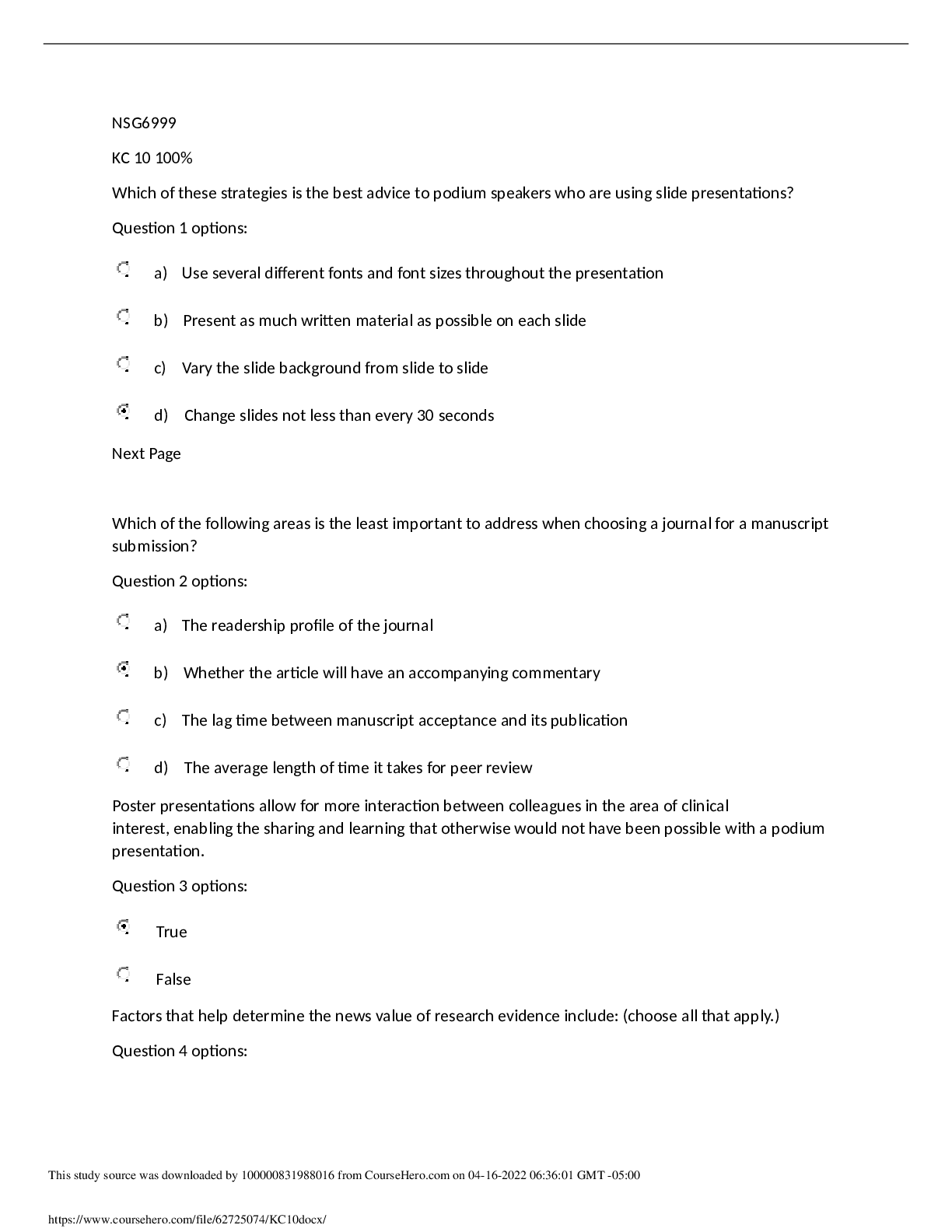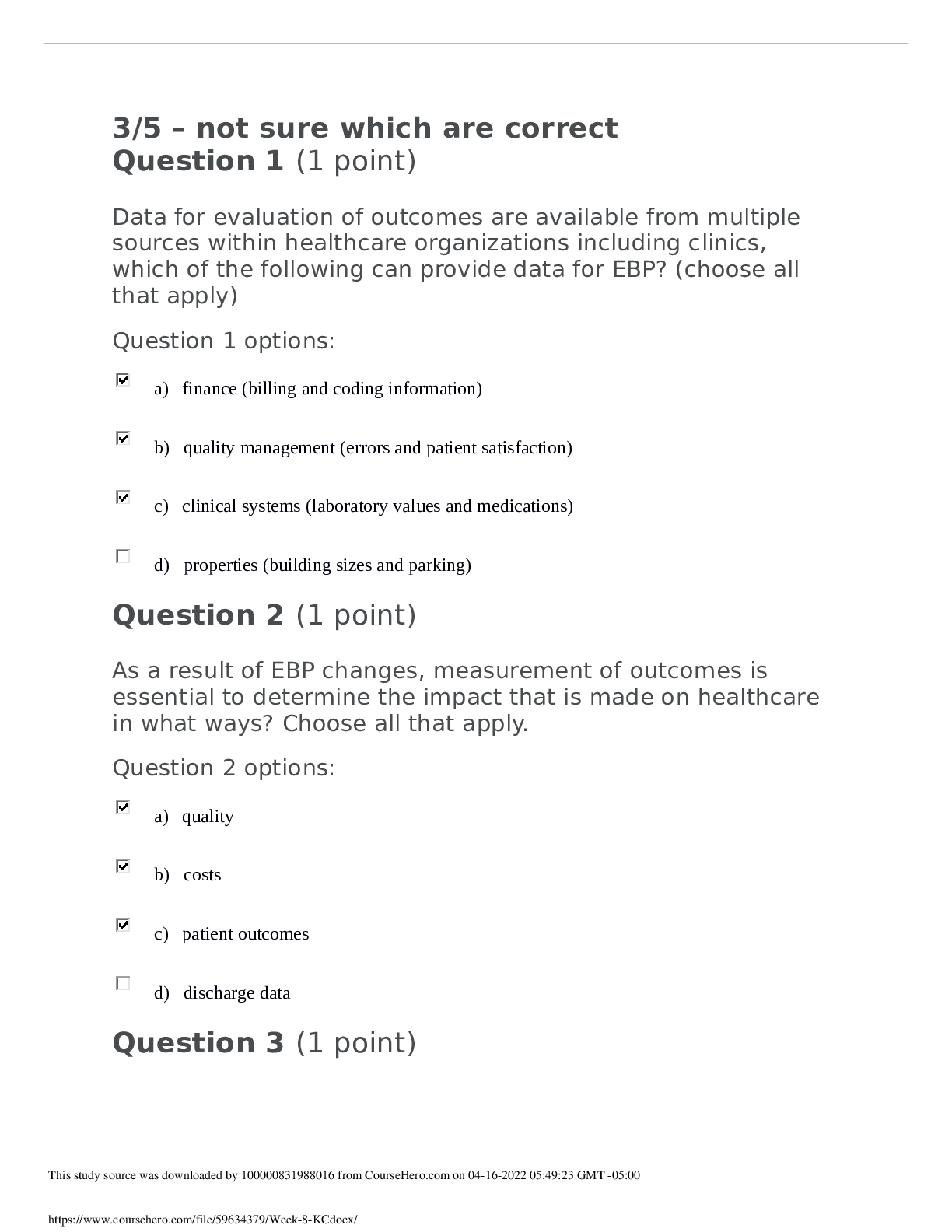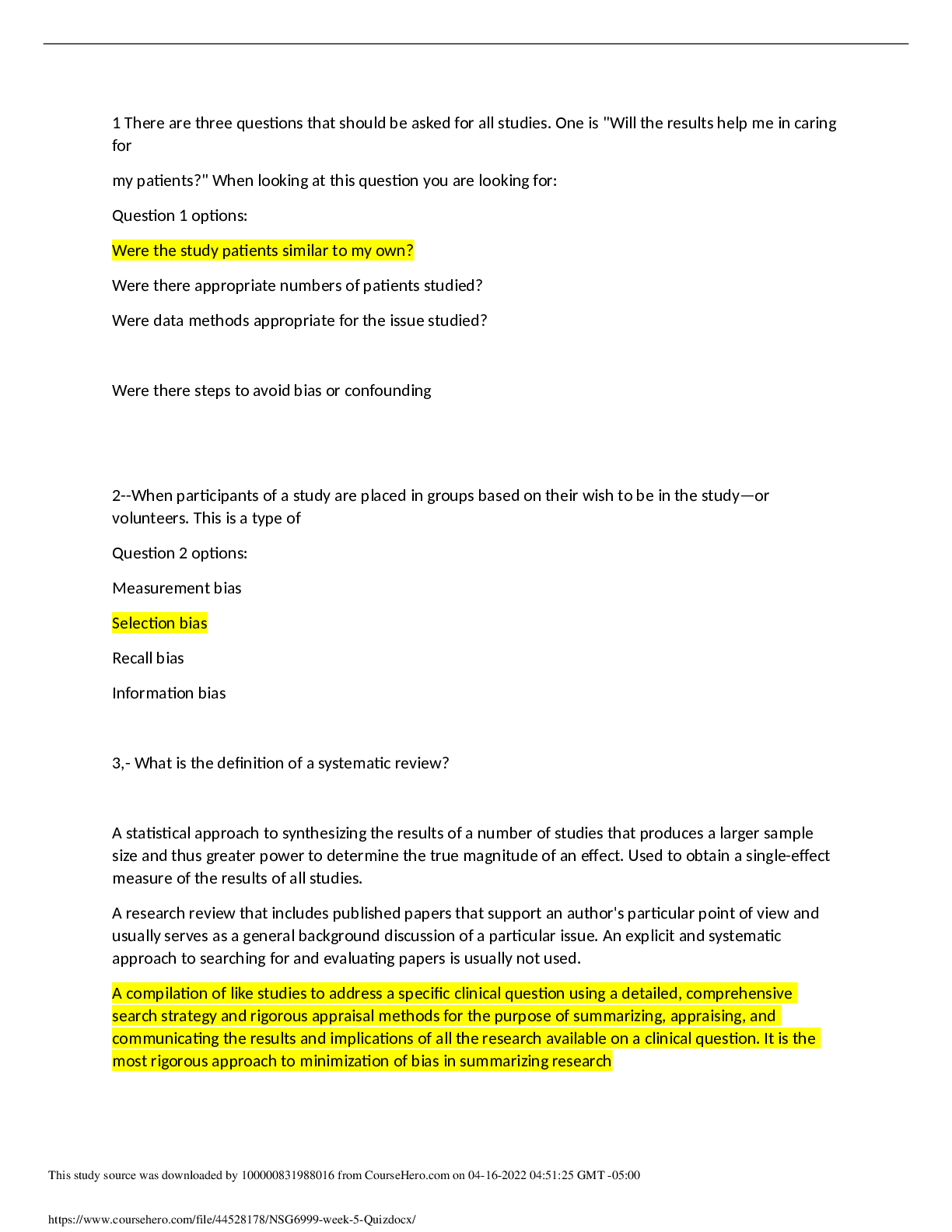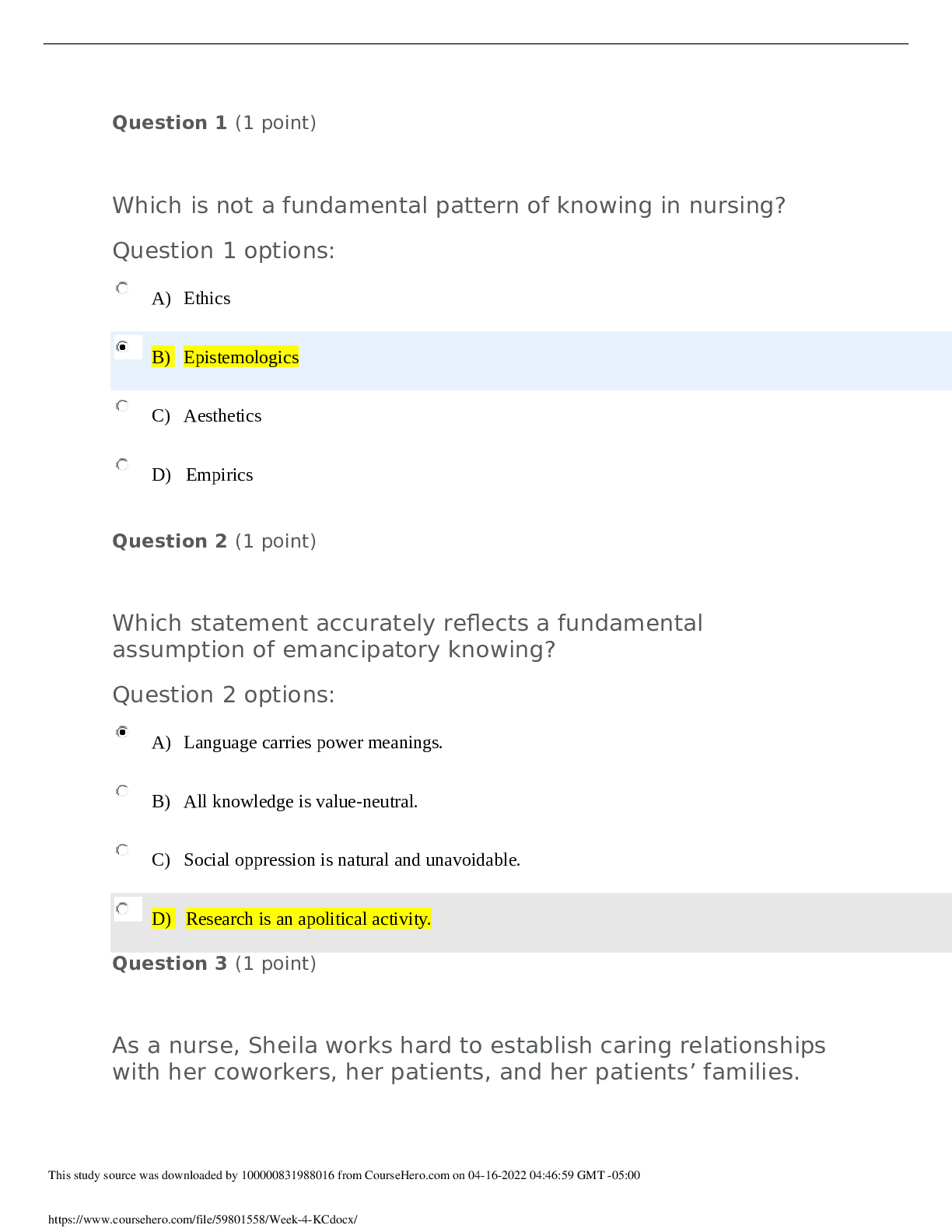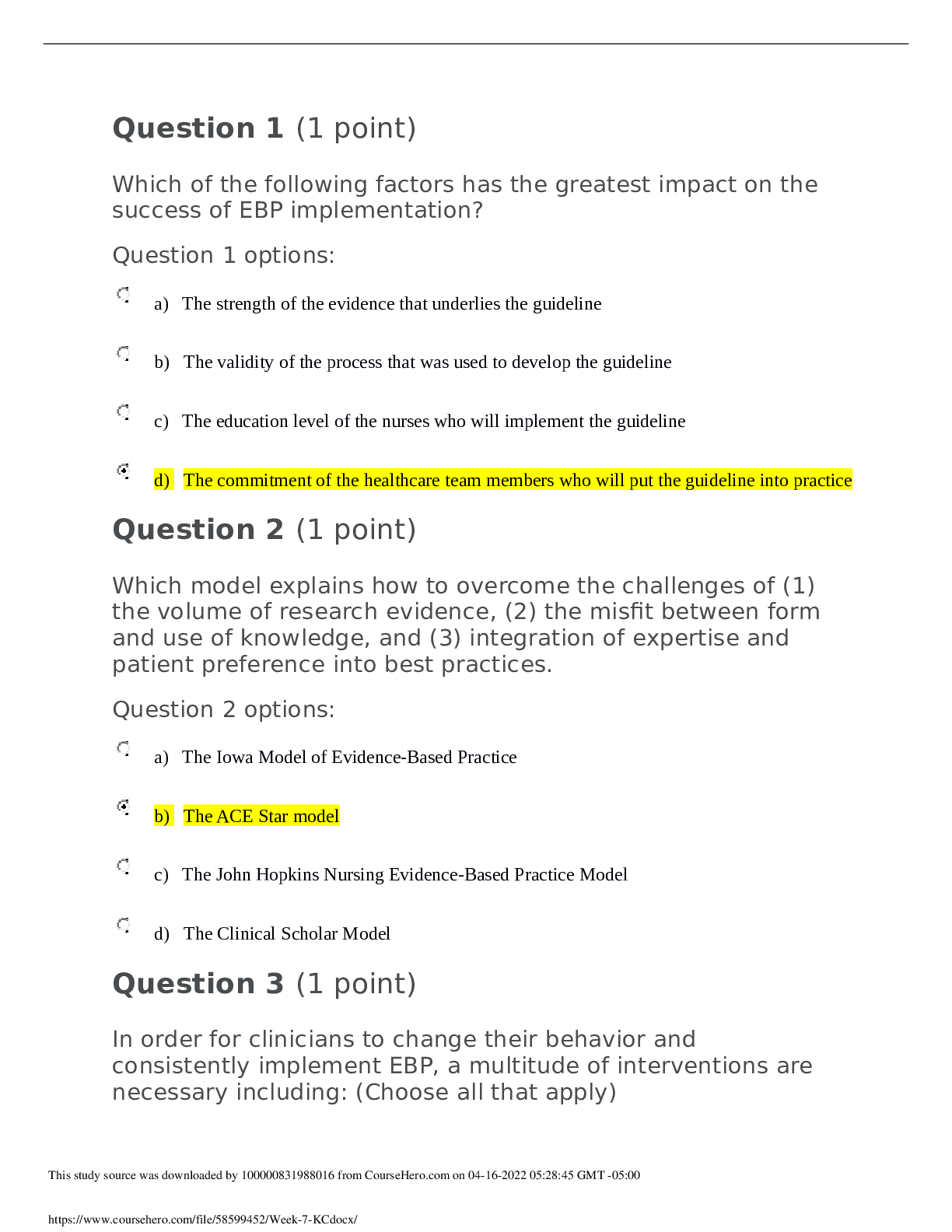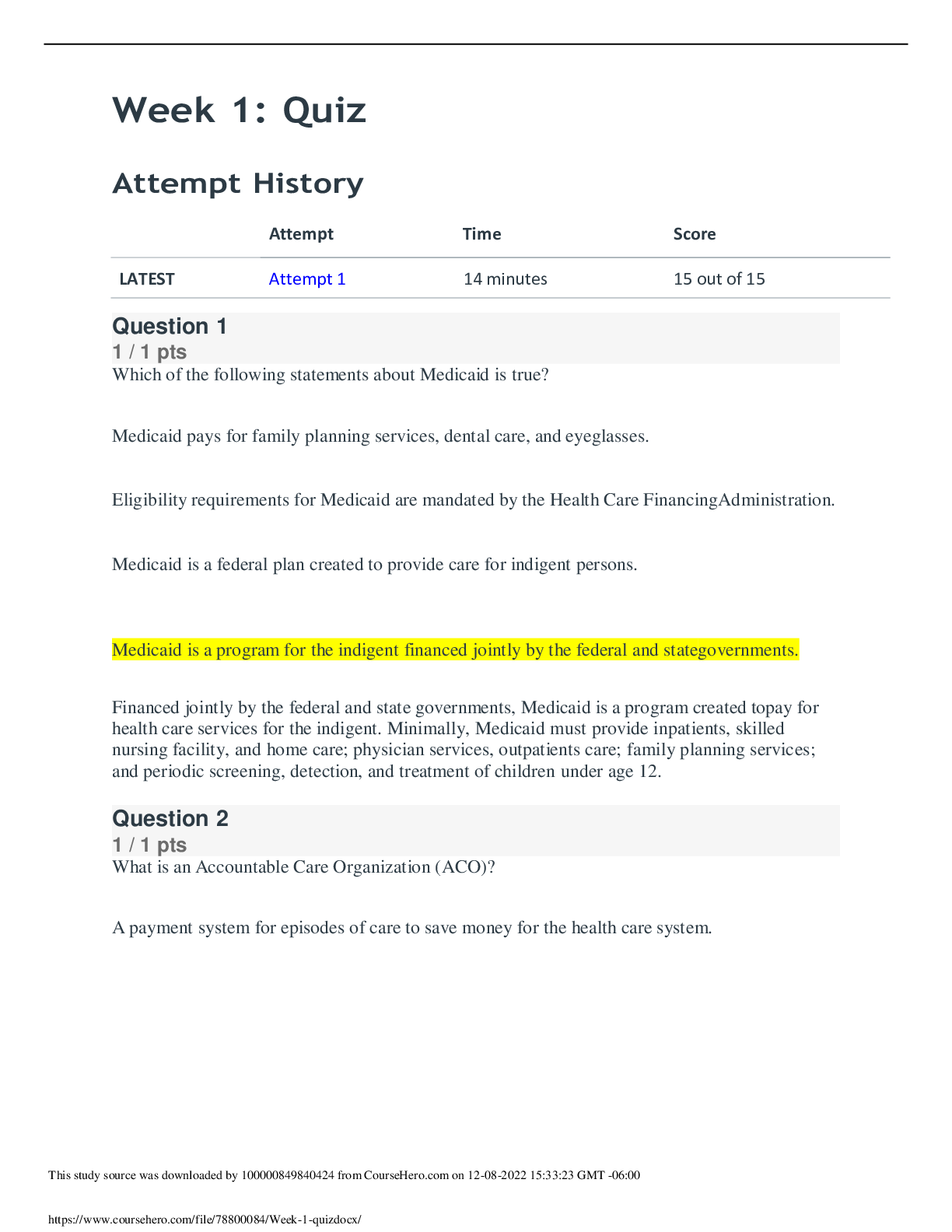*NURSING > QUESTIONS & ANSWERS > NR328 Pediatric Nursing - ATI Quiz / Answer with rationale already verified and complete (All)
NR328 Pediatric Nursing - ATI Quiz / Answer with rationale already verified and complete
Document Content and Description Below
1. A nurse in the emergency department is caring for a 2-year-old child who was found by his parents crying and holding a container of toilet bowl cleaner. The child's lips are edematous and inflamed,... and he is drooling. Which of the following is the priority action by the nurse? a. Remove the child's contaminated clothing. b. Check the child's respiratory status. c. Administer an antidote to the child. d. Establish IV access for the child. 2. A nurse is teaching a parent of a 12-month old child about development during the toddleryears. Which of the following statements should the nurse include? a. "Your child should be referring to himself using the appropriate pronoun by 18 months of age." b. "A toddler's interest in looking at pictures occurs at 20 months of age." c. "A toddler should have daytime control of his bowel and bladder by 24 months of age." d. "Your child should be able to scribble spontaneously using a crayon at the age of 15 months." 3. A nurse is caring for a toddler and is preparing to administer 0.9% sodium chloride 100 mL IV to infuse over 4 hr. The drop factor of the manual IV tubing is 60 gtt/mL. The nurse should set the manual IV infusion to deliver how many gtt/min? (Round the answer to the nearest whole number. Use a leading zero if it applies. Do not use a trailing zero.) 25 gtt Dimensional Analysis 4. A nurse in a pediatric clinic is assessing a toddler at a well-child visit. Which of the following actions should the nurse take? a. Perform the assessment in a head to toe sequence. b. Minimize physical contact with the child initially. c. Explain procedures using medical terminology. d. Stop the assessment if the child becomes uncooperative. 5. A nurse is caring for an 18-year-old adolescent who is up-to-date on immunizations and is planning to attend college. The nurse should inform the client that he should receive which of the following immunizations prior to moving into a campus dormitory? a. Pneumococcal polysaccharide b. Meningococcal polysaccharide c. Rotavirus d. Herpes zoster . 6. A nurse is teaching the parent of an infant about food allergens. Which of the following foods should the nurse include as being the most common food allergy in children? a. Cow's milk b. Wheat bread c. Corn syrup d. Eggs 7. A nurse is teaching the parent of a toddler about home safety. Which of the following statements by the parent indicates an understanding of the teaching? a. "I lock my medications in the medicine cabinet." b. "I keep my child's crib mattress at the highest level." c. "I turn pot handles to the side of my stove while cooking." d. "I will give my child syrup of ipecac if she swallows something poisonous." 8. A nurse is performing a physical assessment on a 6-month-old infant. Which of the following reflexes should the nurse expect to find? a. Stepping b. Babinski c. Extrusion d. Moro 9. A nurse is preparing to administer recommended immunizations to a 2-month-old infant. Which of the following immunizations should the nurse plan to administer? a. Human papillomavirus (HPV) and hepatitis A b. Measles, mumps, rubella (MMR) and tetanus, diphtheria, and acellular pertussis (TDaP) c. Haemophilus influenzae type B (Hib) and inactivated polio virus (IPV) d. Varicella (VAR) and live attenuated influenza vaccine (LAIV) 10. A nurse is developing a plan of care for a school-age child who underwent a surgical procedure that resulted in temporary loss of vision. Which of the following interventions should the nurse include in the plan of care? a. Assign an assistive personnel to feed the child. b. Explain sounds the child is hearing. c. Have the child use a cane when ambulating. d. Rotate nurses caring for the child. 11. A nurse is assessing a 3-year-old child who is 1 day postoperative following a tonsillectomy. Which of the following methods should the nurse use to determine if the child is experiencing pain? a. Ask the parents. b. Use the FACES scale. c. Use the numeric rating scale. d. Check the child's temperature. 12. A nurse is assessing a 6-month-old infant at a well-child visit. Which of the following findings indicates the need for further assessment? a. Grabs feet and pulls them to her mouth b. Posterior fontanel is closed c. Legs remain crossed and extended when supine d. Birth weight has doubled 13. A nurse is observing a mother who is playing peek-a-boo with her 8-month-old child. The mother asks if this game has any developmental significance. The nurse should inform the mother that peek-a-boo helps develop which of the following concepts in the child? a. Hand-eye coordination b. Sense of trust c. Object permanence d. Egocentrism 14. A nurse is caring for a 15-month-old toddler who requires droplet precautions. Which of the following actions should the nurse take? a. Have the toddler wear a disposable gown when in the unit's playroom. b. Wear sterile gloves when changing the toddler's diapers. c. Wear a mask when assisting the toddler with meals. d. Ask visitors to wear an N-95 mask when entering the room. 15. A nurse at a pediatric clinic is assessing a 5-month-old infant during a well-child visit. Which of the following findings should the nurse report to the provider? a. Head lags when pulled from a lying to a sitting position b. Absence of startle and crawl reflexes c. Inability to pick up a rattle after dropping it d. Rolls from back to side 16. A nurse is planning to collect a specimen from a male infant using a urine collection bag. Which of the following actions should the nurse take? a. Wash and dry the infant's genitalia and perineum thoroughly. b. Apply a small coating of water-soluble lubricant to the skin of the infant's perineal area. c. Avoid placing the scrotum inside the collection bag. d. Wait several hours after positioning the device before checking it. 17. A nurse in a pediatric clinic is caring for a 3-year-old child who has a blood lead level of 3 mcg/dL. When teaching the toddler's parents about the correlation of nutrition with lead poisoning, which of the following information is appropriate for the nurse to include in the teaching? a. Decrease the child's vitamin C intake until the blood lead level decreases to zero. b. Administer a folic acid supplement to the child each day. c. Give pancreatic enzymes to the child with meals and snacks. d. Ensure the child's dietary intake of calcium and iron is adequate. 18. A nurse is planning care for a 10-month-old infant who has suspected failure to thrive (FTT). Which of the following interventions should the nurse include in the plan of care? (Select all that apply.) a. Observe the parents' actions when feeding the child. b. Maintain a detailed record of food and fluid intake. c. Follow the child's cues as to when food and fluids are provided. d. Sit beside the child's high chair when feeding the child. e. Play music videos during scheduled meal times. 19. A nurse is assessing a 7-year-old child's psychosocial development. Which of the following findings should the nurse recognize as requiring further evaluation? a. The child prefers playmates of the same sex. b. The child is competitive when playing board games. c. The child complains daily about going to school. d. The child enjoys spending time alone. 20. A nurse is providing education to the parent of a toddler who is about to receive her first dose of the MMR (measles, mumps and rubella) immunization. Which of the following statements by the parent indicates an understanding of the teaching? a. "I am not going to let my child play with other children for 2 days." b. "I will need to return in 2 weeks for my child to receive the varicella immunization." c. "I can give my child acetaminophen for discomfort associated with the immunization." d. "My child might have some discharge from the injection site." 21. A nurse is providing teaching to the parents of a 4-year-old child about fine motor development. Which of the following tasks should the nurse include in the teaching as an expected finding for this age group? a. Copies a circle b. Cuts foods using a table knife c. Begins writing in cursive d. Prints first and last name clearly 22. A nurse is providing teaching to the parents of a 4-year-old child about fine motor development. Which of the following tasks should the nurse include in the teaching as an expected finding for this age group? a. Brightly colored mobile b. Plastic stethoscope c. Small piece jigsaw puzzle d. A book of short stories 23. A nurse in an emergency department is caring for an 8-year old who is up-to-date with current immunization recommendations and has a deep puncture injury. Which of the following should the nurse anticipate administering? a. Diphtheria, tetanus, and acellular pertussis (DTaP) vaccine b. A single injection of tetanus immune globulin (TIG) mixed with the pediatric tetanus booster (DT) c. Tetanus, diphtheria, and acellular pertussis (Tdap) vaccine d. Adult tetanus booster (Td) 24. A nurse is providing teaching about promoting sleep with the parent of a 3-year-old toddler. Which of the following information should the nurse include? a. Follow a nightly routine and established bedtime. b. Encourage active play prior to bedtime. c. Let the child remain awake until tired enough to go to sleep. d. Reward the child with a food treat just prior to sleep if the child goes to bed on time. 25. A nurse is planning to implement relaxation strategies with a young child prior to a painful procedure. Which of the following actions should the nurse take? a. Ask the child to hold his breath and then blow it out slowly. b. Ask the child to describe a pleasurable event. c. Bounce the child gently while holding him upright. d. Rock the child in long rhythmic movements. 26. A nurse is assessing a 6-year-old child at a well-child visit. Which of the following findings requires further assessment by the nurse? a. Presence of sparse, fine pubic hair b. Decreased head circumference compared to full height c. Increased leg length related to height d. Presence of a loose, central incisor 27. A nurse is caring for a preschool-age child who is dying. Which of the following findings is an age-appropriate reaction to death by the child? (Select all that apply.) a. The child views death as similar to sleep. b. The child is interested in what happens to his body after death. c. The child recognizes that death is permanent. d. The child believes his thoughts can cause death. e. The child thinks death is a punishment. 28. A nurse is teaching the parent of an infant about home safety. Which of the following information should the nurse include? a. Use a wheeled infant walker. b. Place soft pillows around the edge of the infant's crib. c. Position the car seat so it is rear-facing. d. Secure a safety gate at the top and bottom of the stairs. e. Maintain the water heater temperature at 49° C (120° F). Infants and children should remain in the rear-facing position when in a car seat until the age of 2 years or until they reach the recommended height and weight per the manufacturer’s guidelines. Securing a safety gate at the top and bottom of the stairs is correct. As the infant begins to crawl and becomes more mobile, the risk of falls increases. Maintaining the water heater temperature at 49° C (120° F) is correct. To prevent a burn injury, the temperature of the water heater should not exceed 49° C (120° F). 29. A nurse is caring for an adolescent who is receiving pain medication via a PCA pump. When the nurse assess the client's pain at 0800, the client describes the pain as a 3 on a scale of 1 to 10. At 100, the client describes the pain as a 5. The nurse discovers the client has not pushed the button to deliver medication in the past 2 hr. Which of the following actions should the nurse take? a. Ask the provider to discontinue the PCA so the nurse can administer PRN pain medication. b. Suggest the client's parent push the button for the client if the parent thinks the adolescent is having pain. c. Reevaluate the client in 1 hr since a pain level of 5 is acceptable on a scale of 1 to 10. d. Reinforce teaching with the client about how to push the button to deliver the med. 30. A nurse is assessing a 12-month-old male infant's vital signs during a well-child visit. The infant is in the 90th percentile of height. Which of the following findings should the nurse report to the provider? a. Heart rate 175/min b. Respiratory rate 26/min c. Blood pressure 88/40 mm Hg) d. Temperature 37.6° C (99.7° F 31. A nurse is teaching the parent of a 12-month-old infant about nutrition. Which of the following statements by the parent indicates a need for further teaching? a. "I can give my baby 4 ounces of juice to drink each day." b. "I will offer my baby dry cereal and chilled banana slices as snacks." c. "I am introducing my baby to the same foods the family eats." d. "My infant drinks at least 2 quarts of skim milk each day." 32. A nurse is assisting a provider during a femoral venipuncture on a toddler. The nurse should place the child in which of the following positions? a. Side-lying b. Semi-recumbent c. Flexed sitting d. Supine 33. A nurse is assessing a 9-month-old infant during a well-child visit. Which of the following findings indicates that the infant has a developmental delay? a. Creeps on hands and knees b. Inability to vocalize vowel sounds c. Uses crude pincer grasp d. Stands by holding onto support 34. A nurse is preparing to administer a liquid medication to an infant. Which of the following actions should the nurse take? a. Administer the medication while the infant is supine. b. Give the medication at the side of the infant's mouth. c. Add the medication to a full bottle of the infant's formula. d. Administer the medication slowly while holding the nares closed. 35. A nurse on a pediatric unit is reviewing the health record of a client who is demonstrating increasing levels of stress after admission. The nurse should identify which of the following findings as a risk factor for a stress-related reaction to hospitalization? a. Age 10 b. First hospitalization c. Male gender d. Calm, quiet demeanor 36. A nurse in the emergency department is caring for a 12-year-old child who has ingested bleach. Which of the following statements by the nurse indicated an understanding of this ingestion? a. "The absence of oral burns excludes the possibility of esophageal burns." b. "Treatment focuses on neutralization of the chemical." c. "Injury by a corrosive liquid is more extensive than by a corrosive solid." d. "Immediate administration of activated charcoal is warranted." 37. A nurse is caring for a child who has a bacterial endocarditis. The child is scheduled to receive moderate term antibiotic therapy and requires a peripherally inserted central catheter (PICC). Which of the following statements should the nurse include when teaching the child's parent? a. "The PICC line will last several weeks with proper care." b. "The public health nurse will rotate the insertion site every 3 days." c. "You will need to make certain the arm board is in place at all times." d. "Your child will go to the operating room to have the line placed." 38. A nurse is providing anticipatory guidance about accidental ingestion of a toxic substance to the parents of a toddler. The nurse should instruct the parents to take which of the following actions first if the child ingests a hazardous substance? a. Give the toddler milk. b. Go to an emergency department. c. Call the poison control center. d. Induce vomiting. 39. A nurse is caring for a 2-year-old child who has cystic fibrosis. The nurse is planning to take the child to the playroom. Which of the following activities would be appropriate for the child? a. Cutting figures from colored paper b. Drawing stick figures using crayons c. Riding a tricycle d. Building towers of blocks 40. A nurse is assessing a 30-month-old toddler during a well-child visit. Which of the following findings requires further assessment by the nurse? a. Primary dentition is complete b. Unable to hop on one foot c. Birth weight is tripled d. Able to state first and last name [Show More]
Last updated: 1 year ago
Preview 1 out of 18 pages
Instant download

Instant download
Reviews( 0 )
Document information
Connected school, study & course
About the document
Uploaded On
Jul 06, 2020
Number of pages
18
Written in
Additional information
This document has been written for:
Uploaded
Jul 06, 2020
Downloads
0
Views
81

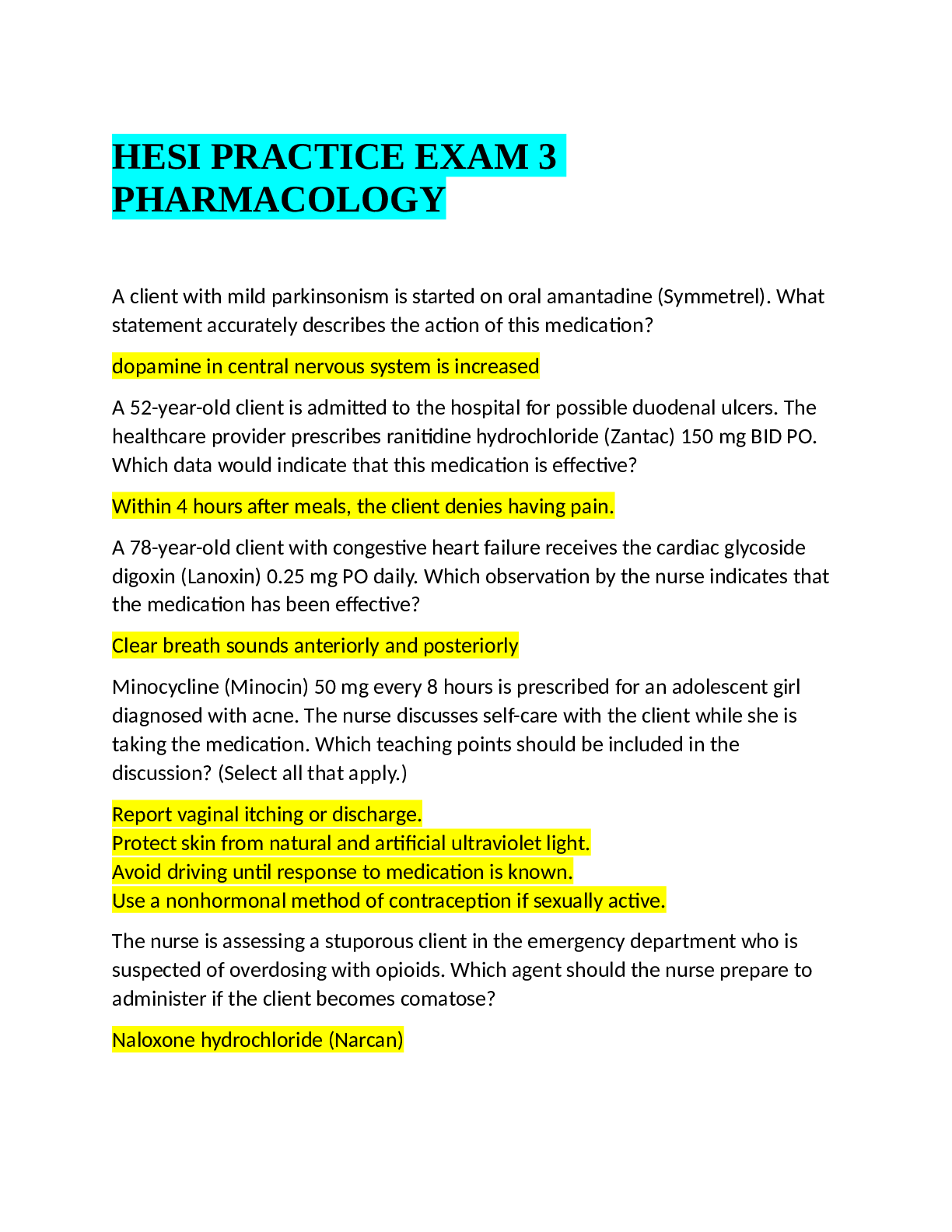
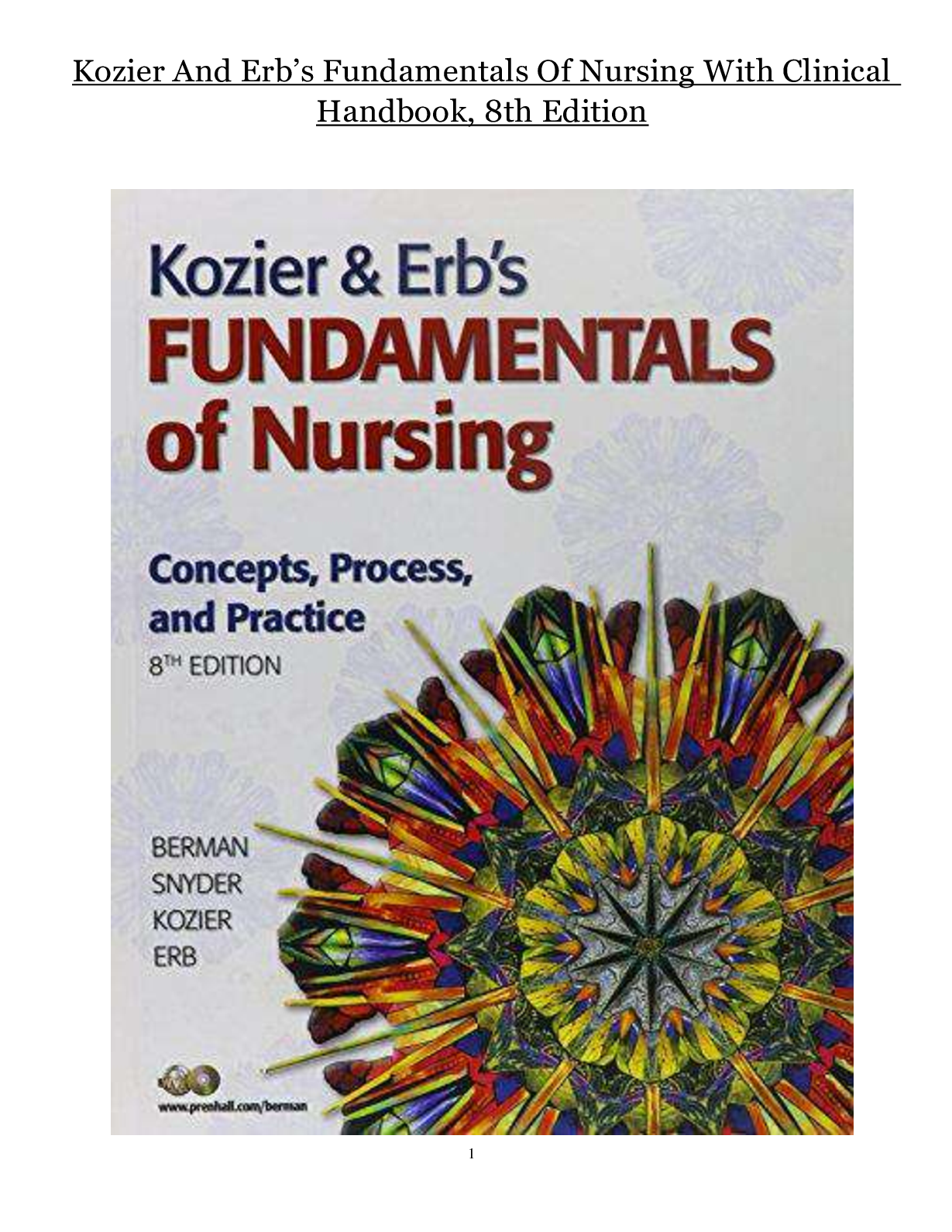
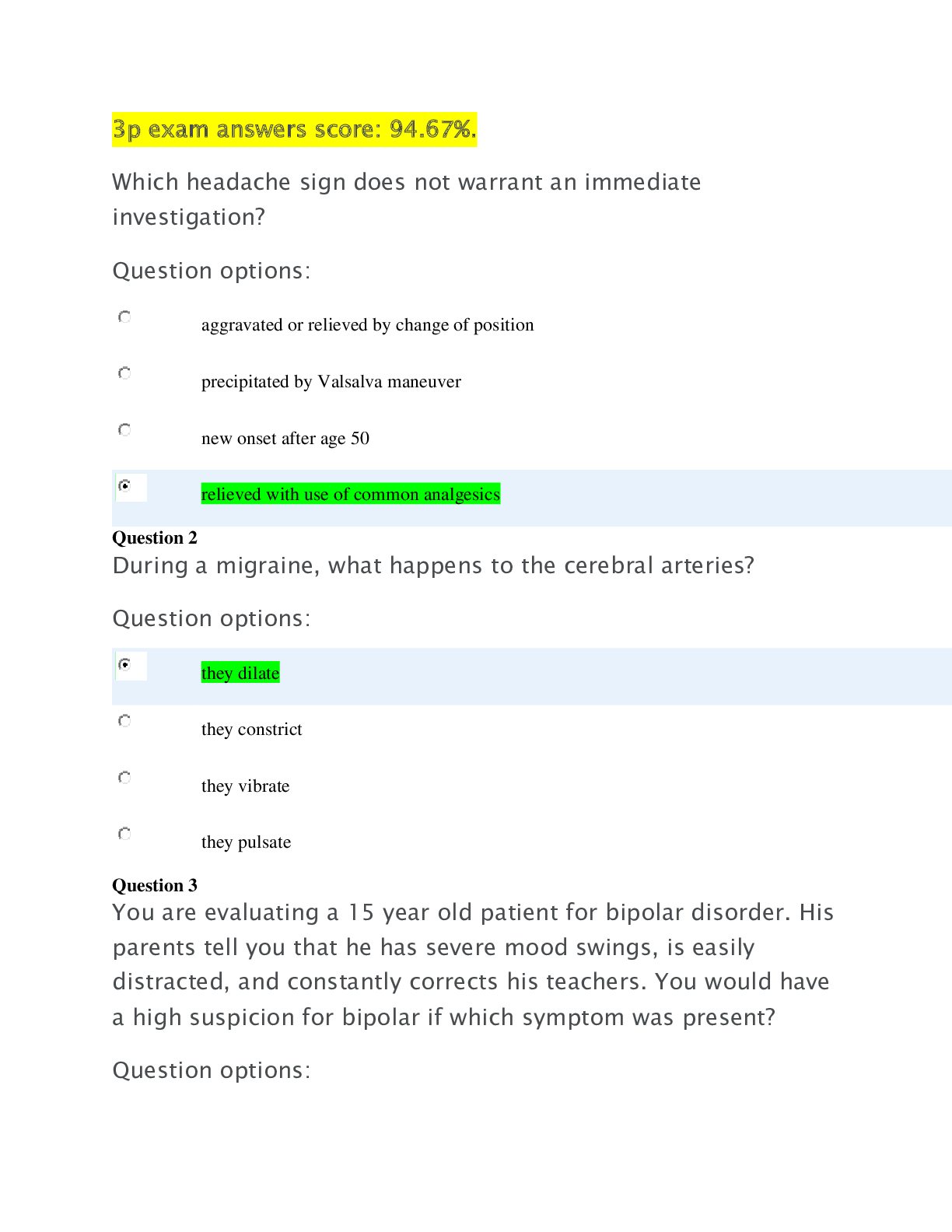
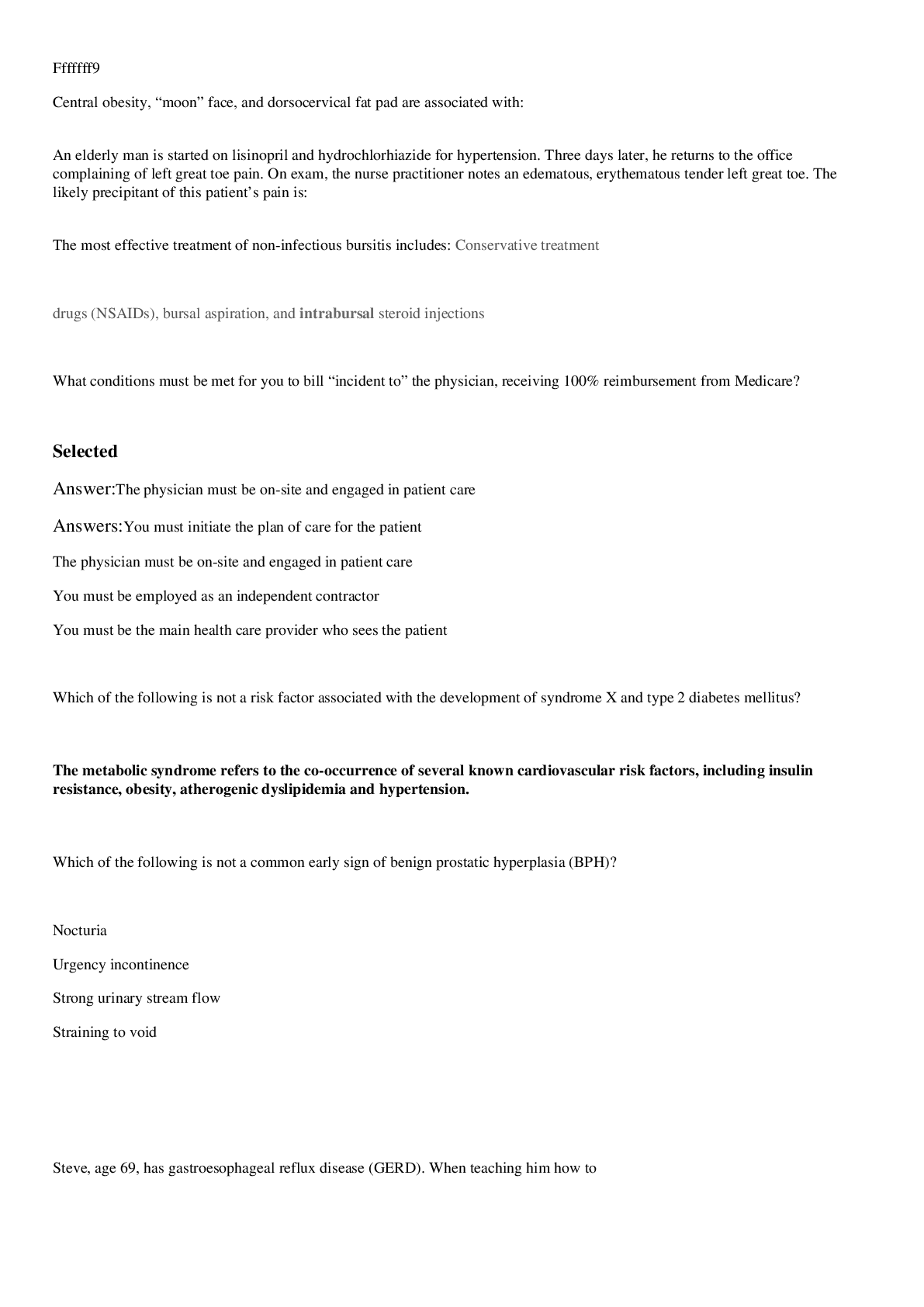
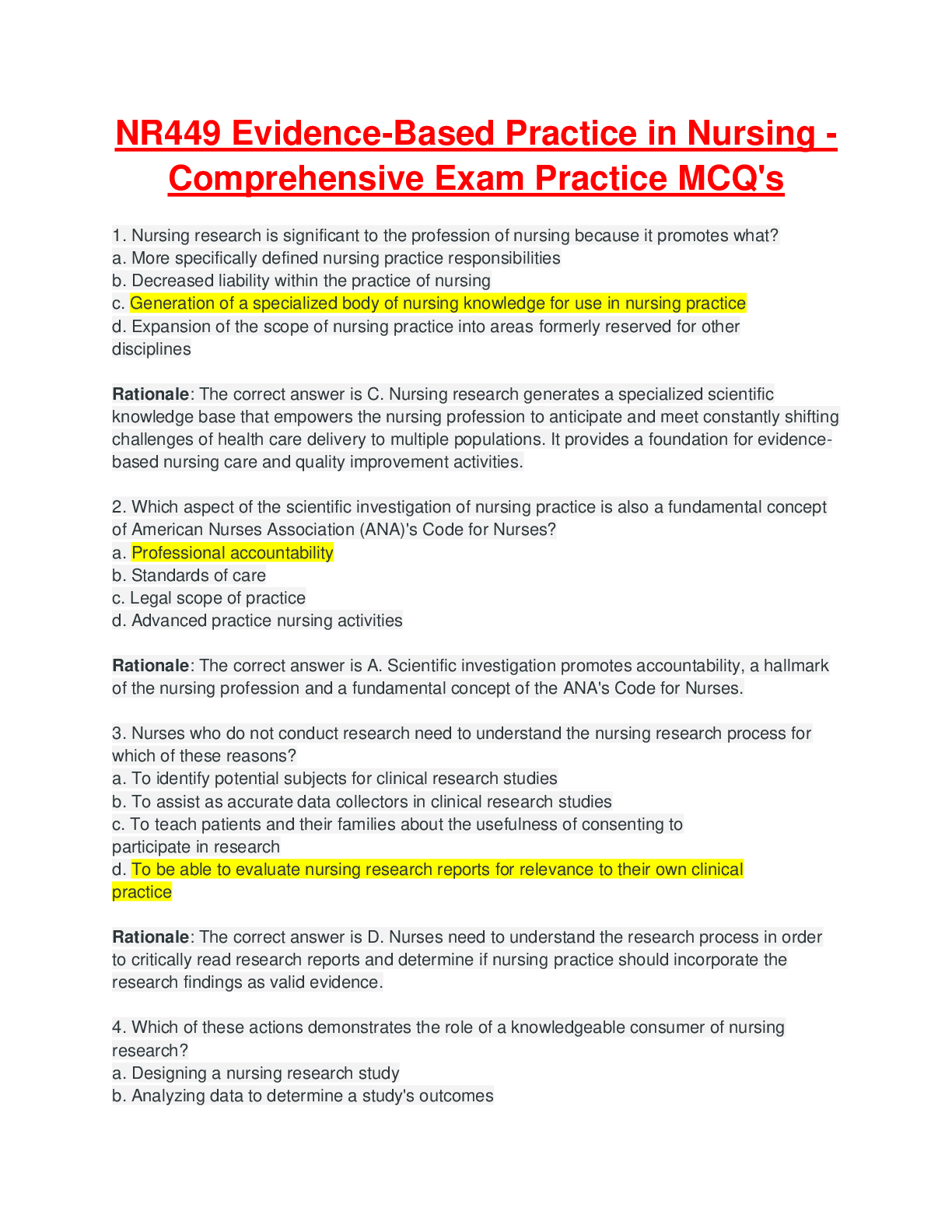
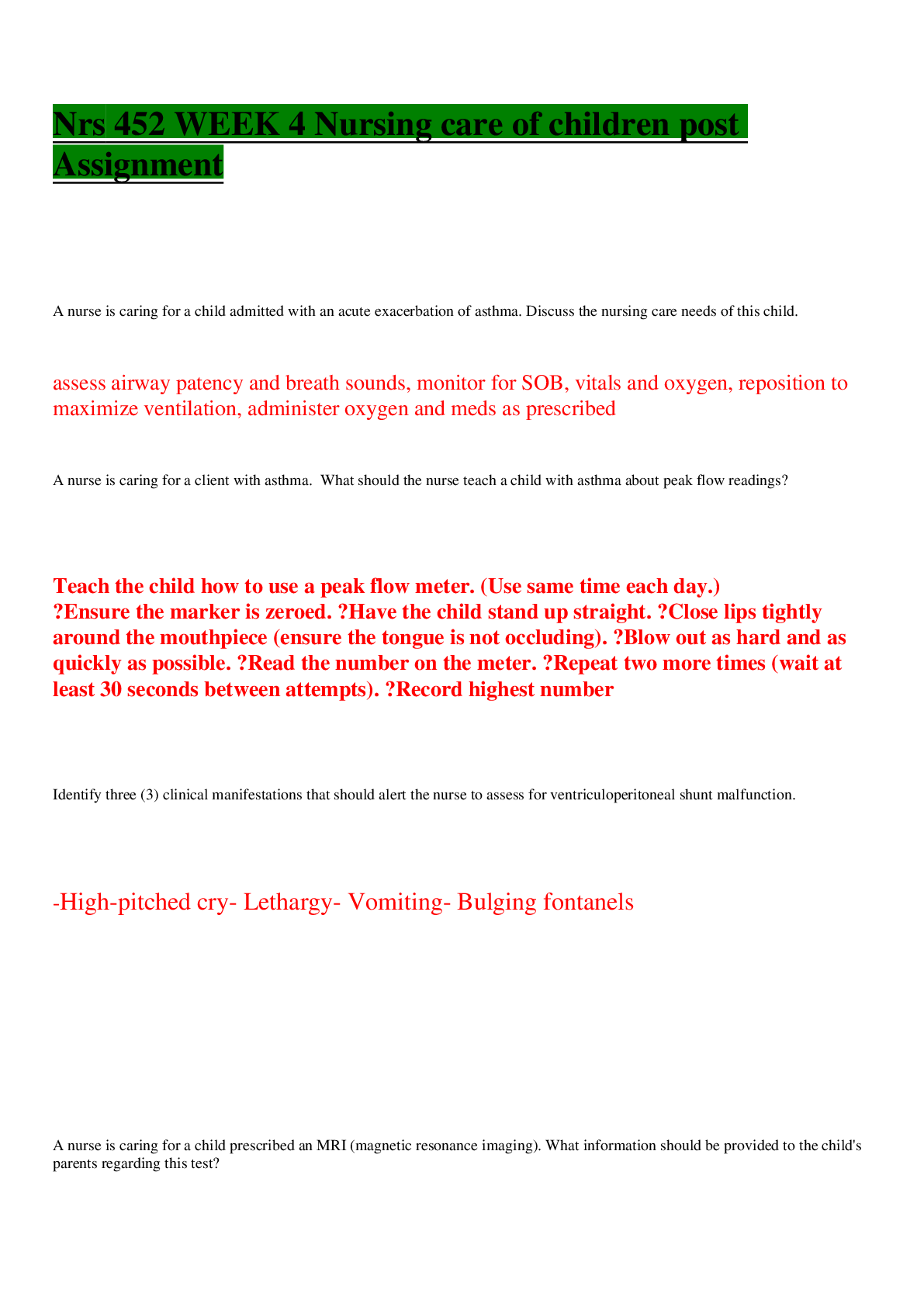
.png)



.png)


.png)

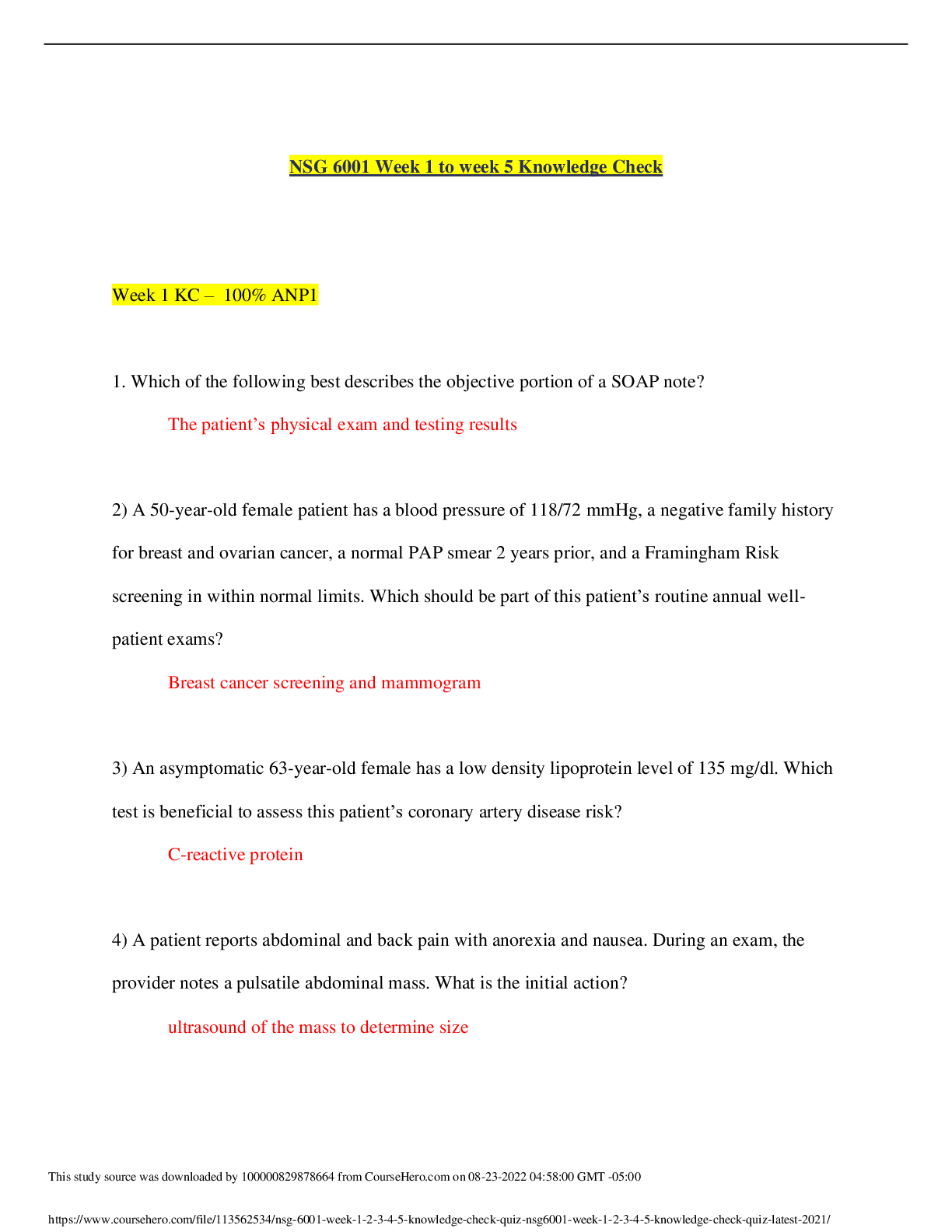
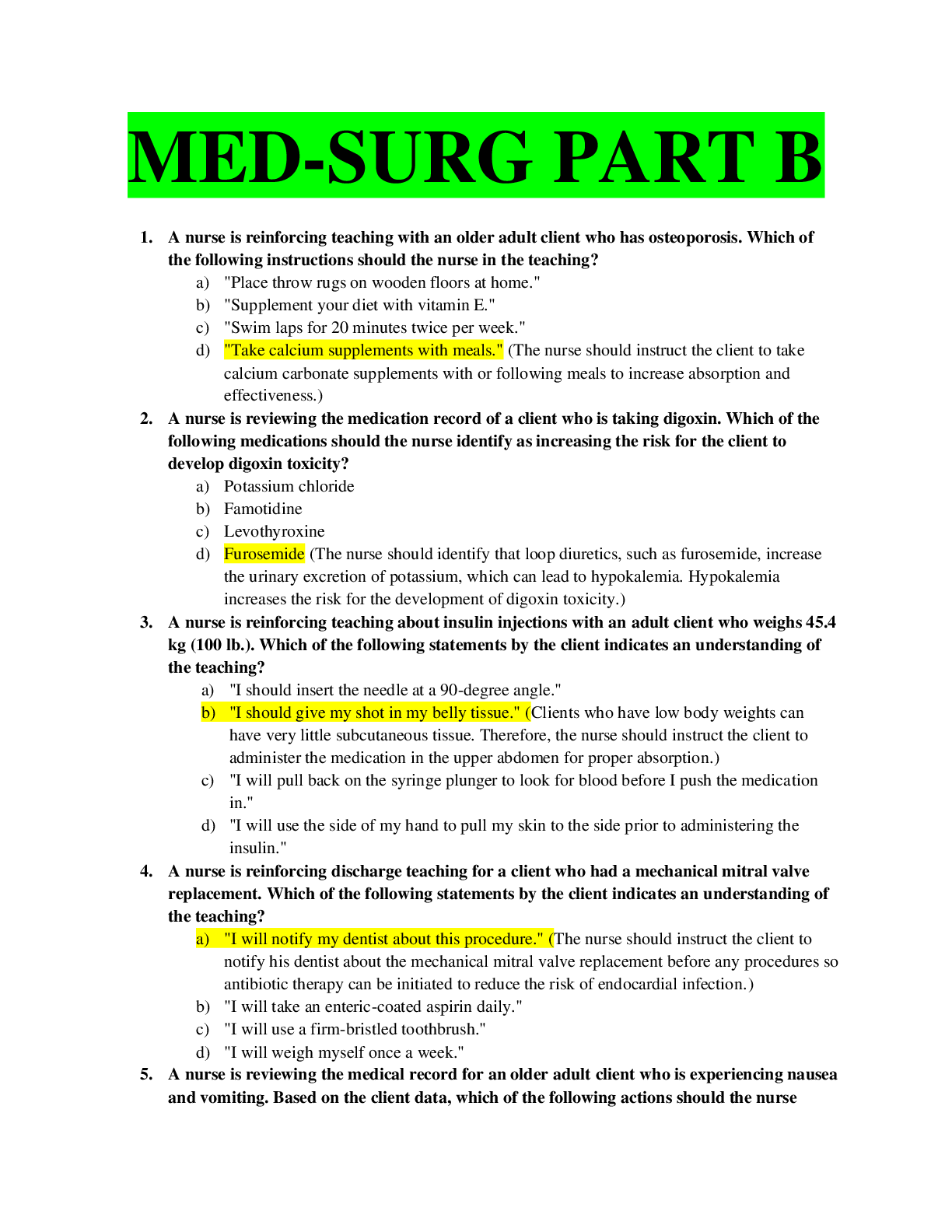
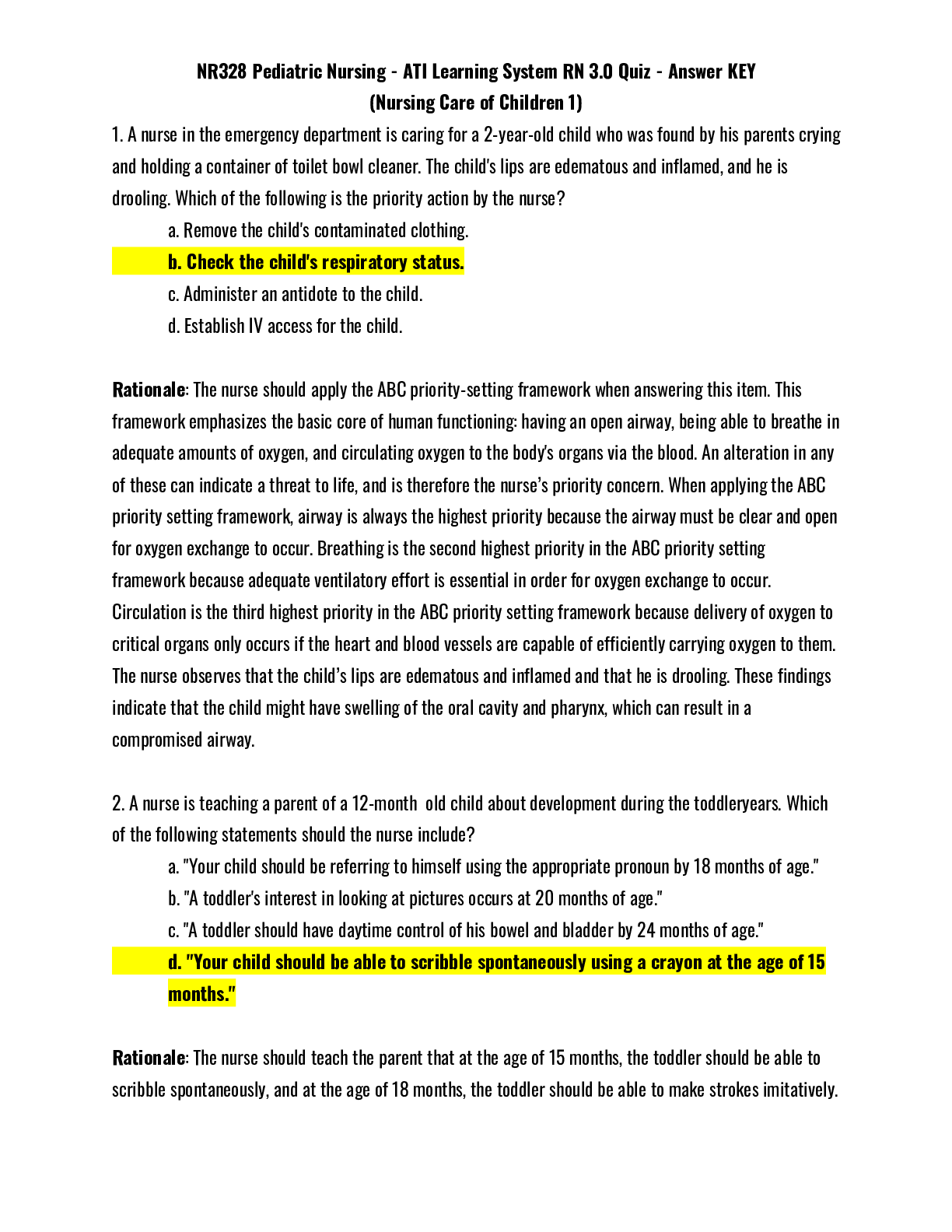
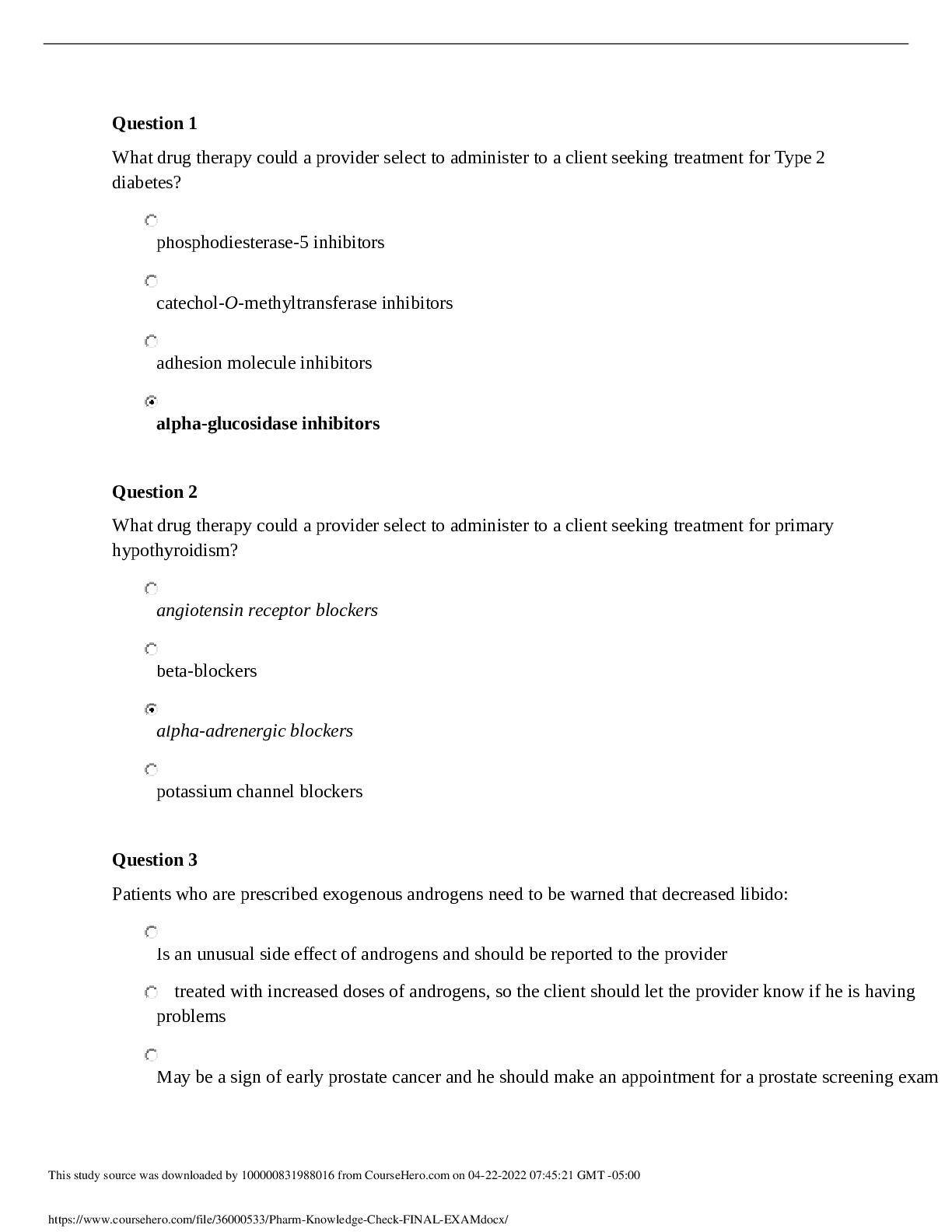
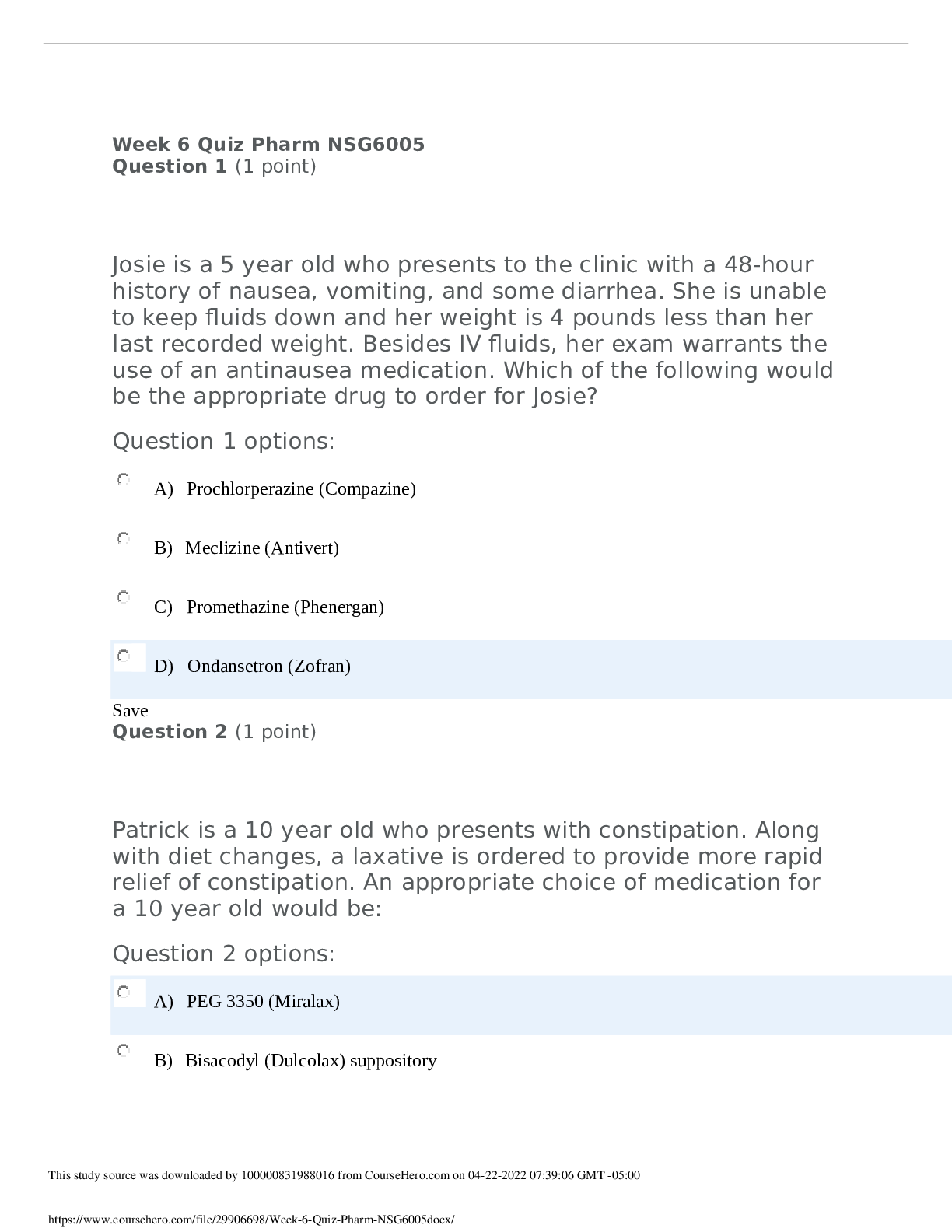
.png)
.png)
.png)
.png)
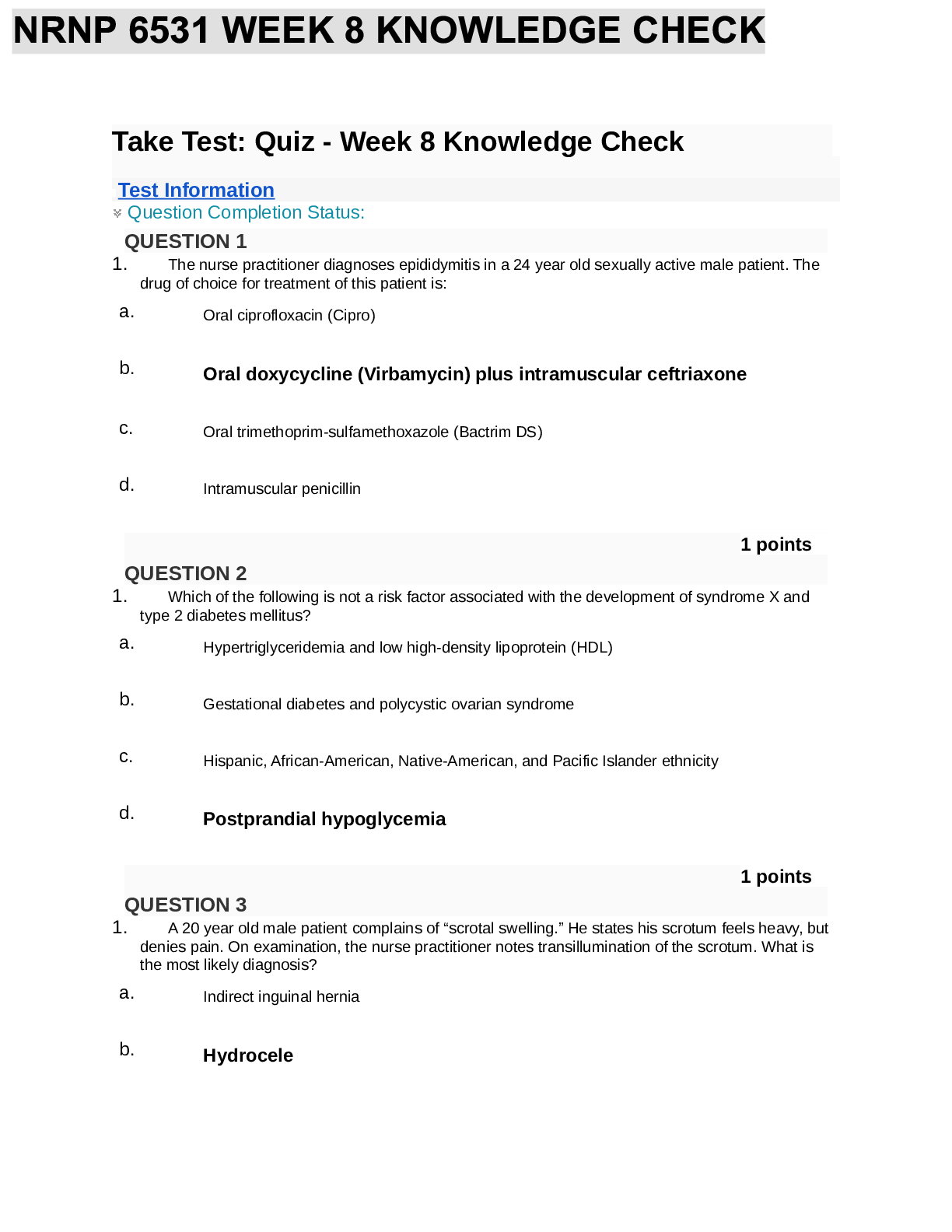
.png)
.png)
